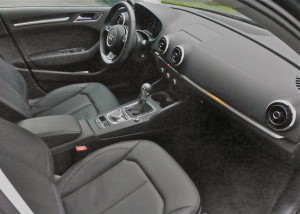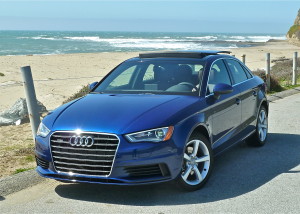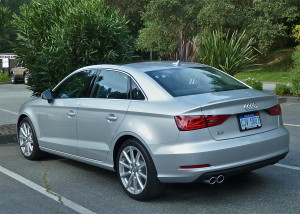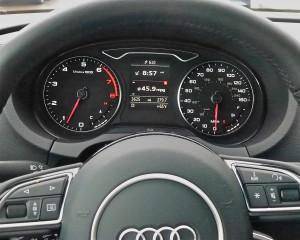Audi Expands A3 to Full Line
By John Gilbert
As the continuing rise of electronic gadgetry and driving controls engulfs the automobile world, I had the occasion to interview a bright young fellow who had left a prominent auto company to go to work for am aftermarket company that makes the electronic gadgets that are aiding and abetting our ability to drive, steer, control, stop, and park our contemporary cars.
I asked him of all the cars he has dealt with in his new job, which one is the most sophisticated from the standpoint of electronic connectivity. He first said the Tesla, which is an all-electric marvel but far from being a mainstream car. Of all the mainstream, readily available cars?
“The Audi A3,” he said, promptly. That is impressive, because I had just driven the first 2015 A3 at Audi’s introduction of the line, and while it is an unobtrusive car, I had noted during the introductory session and test drive, its high-level technology also made it a very sophisticated performer. The car automatically becomes Audi’s entry-level vehicle, starting at $29,900, and if you can resist the option bin you still get an impressive vehicle.
The A3 comes as a 4-door sedan first off, but that is only the leadoff hitter for a lineup of various models that will be part of a full-line segment of Audi’s impressive dossier. The well-loved 2.0-liter 4-cylinder turbocharged engine returns, upgraded to handle the quattro models with Audi’s patented all-wheel-drive system, and it will be joined by a new 1.8-liter turbo that turns the front-wheel-drive A3 into a truly sporty performer with exceptional fuel economy.
On a trip to Germany a few years ago, I first saw the Audi A3, as a smooth, sleek, compact 3-door hatchback. There were some 5-door hatches too, and they seemed to be all over. Anytime you go to Europe, you have to be impressed how European car-owners pack themselves comfortably and easily into efficiently smaller cars, even while U.S. consumers and manufacturers seemed to insist that bigger was better. A year later, when Audi brought the A3 into the U.S. market, I was anxiously awaiting the car, slightly smaller than the stellar A4 sedan, to see both the 4-door and 2-door versions rewrite some of the rules for U.S. entry-level hatchbacks.
I was mostly looking forward to the 3-door, the 2-door hatch, which was about the same size as the Volkswagen Golf. But it showed up in the U.S. market only as the 5-door, the 4-door hatch. My assumption was that Volkswagen, which is Audi’s parent, didn’t want any small hatchback to compete with the Golf, but I’ve never stopped hoping for the 3-door in the U.S.
Times have changed, although the U.S. remains a peculiar market. We seem bound by tradition, and tradition says we don’t buy hatchbacks, so we don’t. In the Volkswagen line, the Jetta 4-door sedan outsells the world-dominant 3-door Golf substantially. Not sure why, but it might have been parent Volkswagen’s decision to not bring in the A3’s 3-door hatch to protect the Golf. Regardless, sales of the 5-door A3 were disappointing, but then, that also is a hatchback.
Audi is setting its sights on changing all that for 2015 when the new generation of the A3 lands in the U.S. Leading off is the 4-door sedan, which we first were shown at the media introduction in San Francisco. No longer a blunt little 5-door subcompact hatchback, the new A3 sedan will be followed by a convertible, with an array of powerplants that starts with the 1.8-liter turbocharged 4, the 2.0 turbo upgrade, with a hotter 2.0 version coming in a soon-to-appear S3, and then a 2.0 turbodiesel model. A 1.4-liter 4 combined with an electric motor system in a hybrid will show up early next year, only in the 5-door hatch.
For starters, though, the 4-door A3 sedan offers plenty. At first sight, it strikes an immediate resemblance to the A4. “What’s the difference in length between this and an A4?” I asked.
“The A3 is 11 inches shorter than the A4,” said Beth Wykes, production manager for the A3.
Wow. Almost a foot shorter. The resemblance, then, is more to the A4 a decade ago, when it was a smaller sedan than the closer-to-midsize sedan it now is. But Wykes had more — much more.
The 4-door sedan will be followed by that cabriolet, which is German-speak for convertible, about the time of the hotter S4. The 5-door version, the only first-generation A3 in the U.S., will be coming by summertime 2015, as a 2015 model, to fill out the full complement of A3 vehicles.
Anyone familiar with Audi also knows how versatile and impressive its 2.0-liter 4-cylinder engine is, bolstered by turbocharging that can be turned up to whatever potency is desired in the TT sports car, for example, or the A4. In Volkswagen’s corporate scheme, what Audi engineers make perfect can fit in nicely to assorted VW vehicles too, which just makes sense.
But now VW has concocted a new and impressive 1.8-liter turbocharged 4 to replace the stodgy 2.5-liter 5-cylinder as the base engine in the Golf, Jetta and various other VWs. So why not make that engine corporate-wide, too? Sure enough, the 1.8 turbo comes as the base engine in the base A3. The strategy makes perfect sense.
The A3 sedan comes in two forms, at launch, with the 1.8 turbo apportioning 170 horsepower and 200 foot-pounds of torque sent to the front wheels via Audi’s S-tronic dual-clutch 6-speed automatic. Technically, it’s not just an automatic, but a clutchless manual that alternates two clutches that grasp alternating gears. That means while you accelerate hard in, say, second gear, the computer knows you’re going to upshift, so the other clutch engages the next gear, and when you shift gears, you merely swap which gear is functioning inside the gearbox.

Austere black A3 interior has no distractions, high-tech connectivity has optional pop-up info screen.
It makes for instantaneous shifts, but while there is a manual gate on the floor shifter to allow you to move the lever over and then manually shift it, there is a conspicuous-by-its-absence lack of steering wheel paddles to let you shift manually without taking your hands off the wheel. I appreciate the manual gate, but having experience VW and Audi products with the slick paddle shifters, not having them is a nuisance.
You cannot get the 1.8 turbo except with the dual-clutch transmission — no stick shift — and you also cannot get it with the quattro all-wheel-drive system — it’s front-wheel-drive only. If you move up in class, and about $5,000 in price, you get the A3 with the 2.0-turbo withquattro and the punch of 220 horsepower and 258 foot-pounds of torque, again with the 6-speed S-tronic dual-cluth shifter.

The 1.8T with front-wheel drive starts under $30,000, just barely, leaving a lot of room to load on some options. My test-drive car had Audi’s navigation system, a cold weather package and aluminum trim package, boosting the price to $34,345 total. Not a bad price for what you get, and about $5,000 less than a comparable 2.0-turbo quattro.
The two cars provide an interesting contrast in capabilities. The quattro, one of the best-proven all-wheel-drive systems on the planet, makes the A3 feel planted to the road in a secure, stable manner. With just the front-wheel drive, the A3 is a surprise, however. It doesn’t feel as solidly planted as the quattro, but instead it feels light and sportier in its demeanor, even if the smaller engine lacks the full punch of the quattro’s 2.0 by about 50 horsepower.
A true sports sedan feels tossable, as though you could come into a tight curve fairly hot, and pretty much fling the car through the curve. That’s the way the A3 with the 1.8 and fwd feels. No question, when you’re pulling onto a highway from a side road, the 2.0 turbo has more immediate power, but the 1.8 isn’t far behind; you just have to run the revs up a little more. The torque comes on at low RPMs, so you need only to step on it hard enough to get into that power and the A3 is well away.
One other comparison was amplified a few weeks after the introduction, when I got the chance to spend a week with the A3 1.8T. The EPA fuel economy estimates for the car are 23 city, 33 highway, for a combined 27 miles per gallon estimated average. But I drove it around in city traffic for three days, then drove from Duluth, MN., to Belle Plaine, in southwestern Minnesota, before the fuel tank ran low. I had gone 400 miles when I filled it, and the zeroed on-board computer showed 38.4 mpg on the freeway at a sustained 70-75 mph. Calculating the refilled tank for half city, half freeway driving, it showed 34 miles per gallon.
There are subcompact strippers with tiny engines that won’t get 38 mpg at highways speeds, or even 34 mpg, and few of them can approach the comfort and interior class of the A3.
Some may find the interior stark and not fancy enough, with its black, soft-touch pebbly stuff all across the dashboard. That’s the way I prefer my interiors, with no need for glitz or distractions, and certainly no need for tacky fake wood. The expansive connectivity is accessed by a fairly simple layout of guidelines surrounding a control knob on the console between the front buckets.
When you start the car, an optional information screen rises out of the dash, much like Volvos used to do, and provides your choice of information, audio and climate controls right there at eye level. Leather seats are both attractive and physically supportive, although the driver’s seat has full electric adjustment while the front passenger must make do with manual controls. An expansive, panoramic sunroof with a retractable sunshade is a nice feature.
The rear seat is cozy, lacking the spaciousness of the A4 and other midsize cars, but it’s adequate for a young family with a couple young kids. The trunk, meanwhile, is enormous. Surprisingly large. It can house a couple of sets of golf clubs or a week’s worth of luggage.
Next, we can look forward to trying the cabrio, and the hotter S3, and the TDI. And I can’t wait for the 5-door, armed with the 1.4/hybrid. All of that almost is enough to make me forgive Audi for the lack of a manual transmission, and for a lack of steering wheel paddles on the 1.8 turbo sedan. We want it to be sporty, but not too sporty? And, I guess in the excitement of the full array of models, we’ll have to overlook the fact that Audi still is not going to give us the 3-door hatchback!





 John Gilbert is a lifetime Minnesotan and career journalist, specializing in cars and sports during and since spending 30 years at the Minneapolis Tribune, now the Star Tribune. More recently, he has continued translating the high-tech world of autos and sharing his passionate insights as a freelance writer/photographer/broadcaster. A member of the prestigious North American Car and Truck of the Year jury since 1993. John can be heard Monday-Friday from 9-11am on 610 KDAL(www.kdal610.com) on the "John Gilbert Show," and writes a column in the Duluth Reader.
John Gilbert is a lifetime Minnesotan and career journalist, specializing in cars and sports during and since spending 30 years at the Minneapolis Tribune, now the Star Tribune. More recently, he has continued translating the high-tech world of autos and sharing his passionate insights as a freelance writer/photographer/broadcaster. A member of the prestigious North American Car and Truck of the Year jury since 1993. John can be heard Monday-Friday from 9-11am on 610 KDAL(www.kdal610.com) on the "John Gilbert Show," and writes a column in the Duluth Reader.